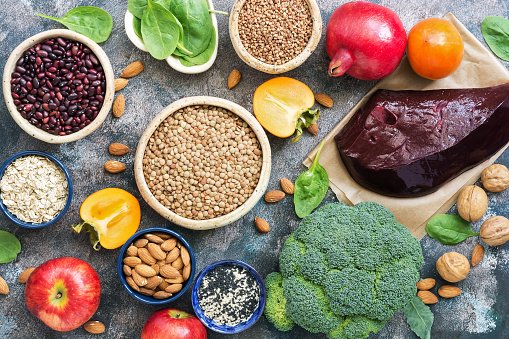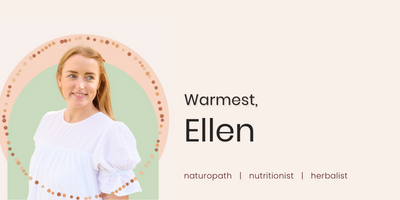Low Iron - Absorption & How Much To Eat?
I see people in my clinic with chronic low iron every single day. It can be debilitating and can be very frustrating when it is so difficult to increase iron levels.
Many of you reading this, at some stage of your life, have probably been told that you are low in iron.
It is very common to be low in iron, especially for women. But what does iron actually do?
Iron is an essential mineral needed for many bodily functions. “Essential mineral” means that we must obtain it from our diet. Without it, oxygen cannot be transported around the body leading to many symptoms, including fatigue. Iron is needed for energy production, but also growth, cell and hormone production and function, and brain development. Although low iron is very common, excess iron is just as troublesome, and can risk damage to body tissues. Which is why it’s super important to have iron testing done before supplementing.
Why Do We Need Iron:
Iron is needed to make haemoglobin, a protein that carries oxygen in the red blood cells from the lungs to all organs and cells of the body.
Iron is required for enzyme reactions in the body to produce hormones, amino acids, collagen and neurotransmitters (chemical messengers that influence mood).
Energy production: A reduction of oxygen to our cells leads to reduced energy levels
DNA synthesis
How to know if you are low in iron?
Low iron can lead to anaemia, a condition where your body cannot make enough red blood cells. Anaemia develops once all your iron stores are depleted. Ferritin is what stores your iron and transferrin is what carries iron throughout the body. All can be measured on a blood test. The optimal reference range for ferritin is 80-100mcg. It’s very common for me to see people with ferritin levels of under 20.
Signs and symptoms of iron-deficiency;
Fatigue
Lack of concentration
Pale skin
Headaches
Weakness/Dizziness
Shortness of breath
Hair loss/ brittle nails
Sources of iron
Iron in food comes in 2 forms, haem Iron and non-haem iron. Haem iron is found in animal products and is best absorbed. Non-haem iron is absorbed less efficiently and is found in plant-based foods. Because of this, vegetarians and vegans are at a higher risk of developing low iron.
Food Sources:
Haem Iron - Beef, lamb, kangaroo, chicken and fish; liver meat is an excellent source - eg chicken liver.
Non-Haem Iron - Dried beans, lentils, legumes, wholegrains, green leafy vegetables, dried apricots, potato with the skin on.
There are certain factors that can either enhance or inhibit iron absorption.
Iron blockers:
Tannins, found in teas, coffee, wine, cocoa, and whole grains
Fibre can bind to iron
Oxalic acid, found in spinach, chard, beans and nuts.
Phytates, found in seeds, nuts, legumes, soy
Calcium and Zinc compete with iron for absorption in the gut.
Poor gut health can impair absorption
ENHANCERS OF IRON:
Consuming vitamin C rich foods at the same time as iron rich foods can improve absorption (same goes for supplements)
Kiwi fruit, capsicum, cruciferous vegetables (broccoli, Brussels sprouts, cabbage, cauliflower), berries, citrus fruits (squeeze lemon over your meal).
Activating your nuts and seeds or rinsing and cooking your legumes well, reduces phytates
Cooking spinach reduces oxalic acid
Can you have too much Iron?
Excess iron can be just as troublesome as low iron. The gut highly regulates how much iron is absorbed. However, a common hereditary disorder, haemochromatosis, compromises the body’s ability to regulate iron stores.
Over supplement use, and frequent blood transfusions can affect the body's regulatory system. Inflammation of iron-rich tissues (liver, lymphatic system & spleen, GI tract, muscle) or use of oestrogens/oral contraceptives can also cause iron excess.
Signs and symptoms of excess iron:
Constipation
Nause &/or vomiting
Abdominal pain
Weakness/Fatigue: This symptom is common in both high and low iron. It is so important to take an iron supplement under the supervision of a practitioner
Weight loss
You can get haemachromatosis gene tested which is a very important one if you have a family history of the condition.
Supplementing with iron:
Supplementing is usually necessary for iron deficiency and if you have been low in iron you were most likely told to get an iron supplement from the chemist. Sure, but were you told what type or how often?
Did you know that not all supplements are the same quality and many supplements are not tolerated well by the gut? Iron supplements come in many forms. Some forms have common side effects, such as constipation, nausea, and vomiting.
Iron bis-glycinate is more gentle on the gut compared to iron contained in products such as Ferrograd or Maltofer. Iron bis-glycinate is generally better tolerated compared to other forms (3). This is because it is in a chelated form, meaning, the digestive system does not need to break it down. Instead, it is passed directly through the stomach and small intestines and absorbed more efficiently with less gut upsets.
Our bodies can only absorb approximately 25 mg of iron per day. It is more effective to supplement every second day rather than every day (1,2). A supplement containing 25 mg of iron bis-glycinate is ideal. A bigger bonus if the supplement contains vitamin C too. It is also important to take away from blockers mentioned above, especially, coffee/tea and supplements like calcium and zinc.
Having insight in what to look for in a supplement should help avoid unwanted gastrointestinal upsets.
If you suspect you may be low, or high in Iron and would like some guidance, please reach out.
Always consult health care practitioner before supplementing.



